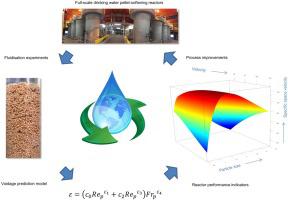Journal of Water Process Engineering ( IF 6.3 ) Pub Date : 2020-07-01 , DOI: 10.1016/j.jwpe.2020.101481 O.J.I. Kramer , P.J. de Moel , J.T. Padding , E.T. Baars , Y.M.F. El Hasadi , E.S. Boek , J.P. van der Hoek

|
In full-scale drinking water production plants in the Netherlands, central softening is widely used for reasons related to public health, client comfort, and economic and environmental benefits. Almost 500 million cubic meters of water is softened annually through seeded crystallisation in fluidised bed reactors. The societal call for a circular economy has put pressure on this treatment process to become more sustainable. By optimising relevant process conditions, the consumption of chemicals can be reduced, and raw materials reused. Optimal process conditions are feasible if the specific crystallisation surface area in the fluidised bed is large enough to support the performance of the seeded crystallisation process. To determine the specific surface area, crucial variables including voidage and particle size must be known. Numerous models can be found in the literature to estimate the voidage in liquid-solid fluidisation processes. Many of these models are based on semi-empirical porous-media-based drag relations like Ergun or semi-empirical terminal-settling based models such as Richardson-Zaki and fitted for monodisperse, almost perfectly round particles. In this study, we present new voidage prediction models based on accurate data obtained from elaborate pilot plant experiments and non-linear symbolic regression methods. The models were compared with the most popular voidage prediction models using different statistical methods. An explicit model for voidage estimation based on the dimensionless Reynolds and Froude numbers is presented here that can be used for a wide range of particle sizes, fluid velocities and temperatures and that can therefore be directly used in water treatment processes such as drinking water pellet softening. The advantage of this model is that there is no need for applying numerical solutions; therefore, it can be explicitly implemented. The prediction errors for classical models from the literature lie between 2.7 % and 11.4 %. With our new model, the voidage prediction error is reduced to 1.9 %.
中文翻译:

使用数据驱动模型的大型饮用水颗粒软化反应器流化系统中的准确空隙预测
在荷兰的大型饮用水生产厂中,中央软化由于与公共卫生,客户舒适度以及经济和环境效益相关的原因而被广泛使用。通过流化床反应器中的晶种结晶,每年将软化近5亿立方米的水。社会对循环经济的呼吁给这种治疗过程带来了压力,要求其变得更加可持续。通过优化相关的工艺条件,可以减少化学药品的消耗并重新利用原材料。如果流化床中的比结晶表面积足够大以支持晶种结晶过程的性能,则最佳工艺条件是可行的。为了确定比表面积,必须知道包括空隙度和粒径的关键变量。在文献中可以找到许多模型来估计液固流化过程中的空隙率。这些模型中的许多模型都基于基于半经验的基于多孔介质的阻力关系(如Ergun)或基于半经验的基于终端沉降的模型(如Richardson-Zaki),并且适用于单分散,几乎完美的圆形颗粒。在这项研究中,我们基于从精心设计的试验工厂实验和非线性符号回归方法获得的准确数据,提出了新的空隙预测模型。使用不同的统计方法将模型与最流行的空隙率预测模型进行了比较。本文介绍了一个基于无因次雷诺数和弗洛德数的显式空隙率估算模型,该模型可用于多种粒径,流体的速度和温度,因此可以直接用于水处理过程中,例如饮用水颗粒的软化。该模型的优点是无需应用数值解。因此,可以明确实现它。的预测误差文献中的经典模型在2.7%至11.4%之间。使用我们的新模型,空隙率预测误差降低到1.9%。











































 京公网安备 11010802027423号
京公网安备 11010802027423号